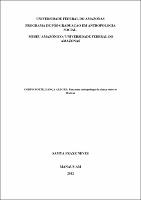| ???jsp.display-item.social.title??? |


|
Please use this identifier to cite or link to this item:
https://tede.ufam.edu.br/handle/tede/2862Full metadata record
| DC Field | Value | Language |
|---|---|---|
| dc.creator | Neves, Samya Fraxe | - |
| dc.creator.Lattes | http://lattes.cnpq.br/6158535447414854 | por |
| dc.contributor.advisor1 | Montardo, Deise Lucy Oliveira | - |
| dc.contributor.advisor1Lattes | http://lattes.cnpq.br/6344437017920336 | por |
| dc.date.available | 2015-04-10 | - |
| dc.date.issued | 2012-11-19 | - |
| dc.identifier.citation | NEVES, Samya Fraxe. Corpo forte, dança alegre: para uma antropologia da dança entre os Waiwai. 2012. 103 f. Dissertação (Mestrado em Antropologia Social) - Universidade Federal do Amazonas, Mestre em Antropologia Social, 2012. | por |
| dc.identifier.uri | http://tede.ufam.edu.br/handle/tede/2862 | - |
| dc.description.resumo | Este trabalho se propõe analisar a dança dos Waiwai, falantes de línguas da família caribe, localizados na aldeia Takará da Terra Indígena Trombeta-Mapuera. Essa sociedade possui dois momentos onde a dança aparece, um no contexto do culto evangélico e o outro nas festas que acontecem na Páscoa, assembleias e no final do ano. A preocupação aqui é observar o uso desses corpos através dos movimentos cotidianos, para compreender os elementos que compõem suas danças. Entendendo que os mesmos elementos que estão presentes nesta arte são inseparáveis dos que aparecem na vida cotidiana. A dança é capaz de colocar em evidência, aspectos indispensáveis para a compreensão de uma cultura, na medida em que, são selecionados para fazer parte de tal arte. Assim, a dança sob a luz da artisticidade passa a ter um importante papel na educação, na construção desses corpos, e, portanto, é também um lugar de ação | por |
| dc.description.abstract | This piece of work aims at analysing the Waiwai people dance, who speak languages of caribe family, located at the tribe of Takará on the Trombeta-Mapuera indigenous land. This society has two periods when dance is seen, one in the context of the evangelic cult and the other in the parties that happen during Easter, gatherings and at the end of the year. The concern here is to watch the use of these bodies through the daily movements, to comprehend the elements which are part of their dances. Understanding that the same elements which are present in this art form are inseparable from what can be seen in their daily lives. The dance is able to put under the spotlight essential aspects to understand a culture, as they are elected to be part of such art form. Therefore, the dance under the artisanship light has an important role in the education, in the building of these bodies, and so, is also a place of action | eng |
| dc.description.sponsorship | Conselho Nacional de Desenvolvimento Científico e Tecnológico | - |
| dc.format | application/pdf | por |
| dc.thumbnail.url | http://200.129.163.131:8080//retrieve/10329/Samya%20Neves.pdf.jpg | * |
| dc.language | por | por |
| dc.publisher | Universidade Federal do Amazonas | por |
| dc.publisher.department | Museu Amazônico | por |
| dc.publisher.country | BR | por |
| dc.publisher.initials | UFAM | por |
| dc.publisher.program | Programa de Pós-graduação em Antropologia Social | por |
| dc.rights | Acesso Aberto | por |
| dc.subject | Movimento | por |
| dc.subject | Antropologia da dança | por |
| dc.subject | Waiwai | por |
| dc.subject | Movement | eng |
| dc.subject | Dance anthropology | eng |
| dc.subject | Waiwai | eng |
| dc.subject.cnpq | CIENCIAS HUMANAS: ANTROPOLOGIA | por |
| dc.title | Corpo forte, dança alegre: para uma antropologia da dança entre os Waiwai | por |
| dc.type | Dissertação | por |
| Appears in Collections: | Mestrado em Antropologia Social | |
Files in This Item:
| File | Description | Size | Format | |
|---|---|---|---|---|
| Samya Neves.pdf | 6.8 MB | Adobe PDF |  Download/Open Preview |
Items in DSpace are protected by copyright, with all rights reserved, unless otherwise indicated.




